This week’s article will introduce the reader to one of the world’s greatest automobile endurance races, the 24 Heures Du Mans or simply the iconic “Le Mans”. The very first race was assembled and showcased by the “Automobile Club De L’Ouest” in France in 1923. The grueling race course measured 17.1 kilometers and weaved through the streets of Le Mans, the course was aptly named Circuit De La Sarthe, in honour of the river with the same namesake. Today, 24 Heures Du Mans remains the world’s oldest and continuously active marathon endurance race. The race is both grueling for machines as it is for humans. Wrongfully, the Le Mans format is commonly associated with Formula 1 and nothing could be farther from the truth.
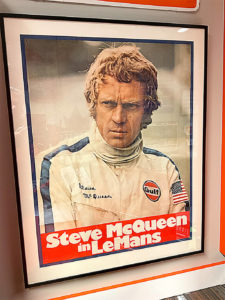 Formula 1 races are mere short sprints in comparison to the Le Mans format… Virtually a super marathon, a test of skill, mental toughness, physical grit and mechanical reliance and reliability. At its inception the race was merely a proving ground for automobiles of the area, to showcase and highlight their mechanical reliability and subsequent endurance.
Formula 1 races are mere short sprints in comparison to the Le Mans format… Virtually a super marathon, a test of skill, mental toughness, physical grit and mechanical reliance and reliability. At its inception the race was merely a proving ground for automobiles of the area, to showcase and highlight their mechanical reliability and subsequent endurance.
The original race was held on May 26 and 27, 1923 through the public streets of Le Mans and not on a track, like others at the time. The early years were of course dominated by the French in their own country; however, competition began to mount from primarily the Italians and English. The first race in 1923 was won by French drivers Rene Leonard and Andre Lagache. They both travelled a total of 2,080 KMS in the allotted 24-hour period. Their vehicle of choice was a Chenard and Walcker, 3 litre. The format allows each driver to singly drive the team’s car, while the other rests, sleeps or merely waits on the sidelines for their new shift.
The first race included 33 cars and 66 drivers and remarkably a total of 63 actually finished the 24-hour endurance race. Each year the race was held until 1936. Until general labour unrest in France caused it to be cancelled. Further in 1939, the declaration and breakout of WWII, caused the annual race’s suspension and it did not return until 1949.
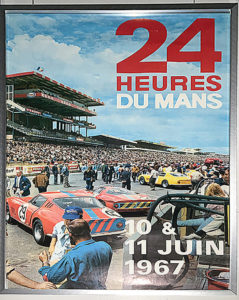 When it eventually did return it did so with a vengeance, with a vast list of newcomer automobile companies. The year marked the very first in which over 100 entries registered, although the governing club had to trim the field by more than 50%. Ferrari claimed its first victory in 1949, after countless years of falling up short to Alfa Romeo, also of Italy. The World Sportscar Championship circuit was formed in 1953, a series of endurance racing events in which Le Mans itself became involved. Le Mans was the perfect stage for highlighting new technologies from the likes of Aston Martin, Mercedes, Jaguar and Ferrari. The first car to reach 300 KPH was a Ferrari 330 LMB in 1963. The 330 LMB was so successful that it triumphed in 6 straight Le Mans races from 1960 to 1965. This feat definitely solidified Ferrari as the premier race car producer in the world, at that time. The European Reign was toppled in 1966, when Ford Motor Company, introduced the GT40, aptly named for being 40” overall in height. Ferrari did not win at all that year and were completely shut out of any podium. As a matter of fact, all three Ford cars claimed gold, silver and bronze. The difference between gold and silver was a mere 8 meters.
When it eventually did return it did so with a vengeance, with a vast list of newcomer automobile companies. The year marked the very first in which over 100 entries registered, although the governing club had to trim the field by more than 50%. Ferrari claimed its first victory in 1949, after countless years of falling up short to Alfa Romeo, also of Italy. The World Sportscar Championship circuit was formed in 1953, a series of endurance racing events in which Le Mans itself became involved. Le Mans was the perfect stage for highlighting new technologies from the likes of Aston Martin, Mercedes, Jaguar and Ferrari. The first car to reach 300 KPH was a Ferrari 330 LMB in 1963. The 330 LMB was so successful that it triumphed in 6 straight Le Mans races from 1960 to 1965. This feat definitely solidified Ferrari as the premier race car producer in the world, at that time. The European Reign was toppled in 1966, when Ford Motor Company, introduced the GT40, aptly named for being 40” overall in height. Ferrari did not win at all that year and were completely shut out of any podium. As a matter of fact, all three Ford cars claimed gold, silver and bronze. The difference between gold and silver was a mere 8 meters.
Over the next four years, Ford finished in first place. Henry Ford II officially and proudly announced that mighty American engineering had finally been delivered to Europe.
As technology and design evolved, cars became faster and speeds skyrocketed. The big screen featured Steve McQueen (A Man’s Man) in the blockbuster “Le Mans” film in 1971. McQueen’s car was the famed Porsche 917 and it actually won two races in a row in the early and an additional two in the late 1970’s. Also, in the late 1970’s the starting rules changed. Drivers no longer had to run to get into their cars, they simply began with a rolling start. It should be noted that Porsche to this day still has the ignition on the left portion of the steering column. This design enabled the driver to start with left hand, clutch with left foot and shift with right hand and brake with right foot, simultaneously if need be.
The following form part of the collection:
- 1971 – Original “Le Mans” movie poster, 24” x 30” with four original crease marks, from being shipped flat. C-9 condition.
- 1965 – Original race poster, 19-20 June 1965. Size of 14” x 22”, pristine and C-10 condition.
- 1967 – Original race poster, 10-11 June 1967. Size of 14” x 22”, pristine and C-10 condition.
- Small collage of various original “Le Mans” race posters, all sized 14” x 22” and lithographed with automobile Clube De L’Ouest. C-10 condition.
Armando Terra/MS
texto em português
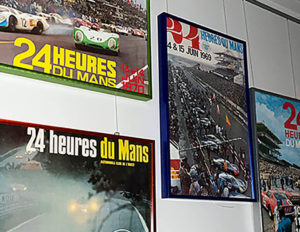
24 Horas de Le Mans
O artigo desta semana apresentará ao leitor uma das maiores corridas de resistência automóvel do mundo, as 24 Horas de Le Mans ou, simplesmente, o icónico “Le Mans”. A primeira corrida foi montada e exibida pelo “Automobile Club De L’Ouest” em França em 1923. O cansativo percurso de corrida tinha 17,1 quilómetros nas ruas de Le Mans, o percurso foi apropriadamente denominada Circuit De La Sarthe, em honra do rio com o mesmo nome. Hoje, 24 Heures Du Mans continua a ser a mais antiga e continuamente ativa corrida/maratona de resistência. A corrida é cansativa tanto para as máquinas, como para os humanos. Erradamente, o formato Le Mans é comumente associado à Formula 1 e nada poderia estar mais longe da verdade.
As corridas de Fórmula 1 são meros sprints curtos em comparação com o formato Le Mans… verdadeiramente uma super maratona, um teste de habilidade, dureza mental, coragem física, confiança mecânica e fiabilidade. No seu início, a corrida foi apenas um terreno de prova para os automóveis da área, para mostrar e destacar a sua fiabilidade mecânica e subsequente resistência.
A corrida original foi realizada nos dias 26 e 27 de maio de 1923 pelas ruas públicas de Le Mans e não numa pista, como outros na época. Os primeiros anos foram, naturalmente, dominados pelos franceses no seu próprio país, é claro; no entanto, a competição começou a ganhar projeção, principalmente, graças aos italianos e ingleses. A primeira corrida em 1923 foi ganha pelos pilotos franceses Rene Leonard e Andre Lagache. Ambos viajaram um total de 2.080 kms no período de 24 horas. O seu veículo de eleição era um Chenard e Walcker de 3 litros. O formato permite que cada condutor conduza o carro da equipa, enquanto o outro descansa, dorme ou apenas espera nas linhas laterais pelo seu novo turno.
 A primeira corrida incluiu 33 carros e 66 pilotos e um total notável de 63 realmente terminaram a corrida de 24 horas de resistência. Todos os anos a corrida foi realizada até 1936, até que a agitação geral do trabalho em França fez com que fosse cancelada. Mais além, em 1939, a declaração e a fuga da Segunda Guerra Mundial causaram a suspensão anual da corrida e só regressaram em 1949.
A primeira corrida incluiu 33 carros e 66 pilotos e um total notável de 63 realmente terminaram a corrida de 24 horas de resistência. Todos os anos a corrida foi realizada até 1936, até que a agitação geral do trabalho em França fez com que fosse cancelada. Mais além, em 1939, a declaração e a fuga da Segunda Guerra Mundial causaram a suspensão anual da corrida e só regressaram em 1949.
Quando acabou por regressar fê-lo com uma vingança, com uma vasta lista de empresas de automóveis recém-chegadas. O ano ficou marcado por ter sido o primeiro em que mais de 100 inscrições foram feitas, embora o clube dirigente tenha tido de cortar os inscritos em mais de 50%. A Ferrari conquistou a sua primeira vitória em 1949, depois de inúmeros anos a ficar aquém da Alfa Romeo, também de Itália. O circuito do Campeonato Mundial de Sportscar foi formado em 1953, uma série de provas de corrida de resistência em que o próprio Le Mans se envolveu. Le Mans foi o palco perfeito para destacar novas tecnologias como a Aston Martin, Mercedes, Jaguar e Ferrari. O primeiro carro a chegar aos 300 KPH foi um Ferrari 330 LMB em 1963. O 330 LMB foi tão bem-sucedido que triunfou em 6 corridas consecutivas de Le Mans de 1960 a 1965. Esta proeza solidificou definitivamente a Ferrari como o principal produtor de carros de corrida do mundo, na altura. O reinado europeu foi derrubado em 1966, quando a Ford Motor Company introduziu o GT40, devidamente nomeado por ter 40” em altura. A Ferrari não ganhou nada nesse ano e ficou completamente fora de qualquer pódio. Na verdade, os três carros da Ford reclamaram ouro, prata e bronze. A diferença entre ouro e prata foi de apenas 8 metros.
 Nos quatro anos seguintes, Ford terminou em primeiro lugar. Henry Ford II oficialmente e orgulhosamente anunciado na poderosa engenharia americana tinha finalmente sido entregue à Europa.
Nos quatro anos seguintes, Ford terminou em primeiro lugar. Henry Ford II oficialmente e orgulhosamente anunciado na poderosa engenharia americana tinha finalmente sido entregue à Europa.
À medida que a tecnologia e o design evoluíram, os carros tornaram-se mais rápidos e as velocidades dispararam. O grande ecrã contou com Steve McQueen (A Man’s Man) no filme de blockbuster “Le Mans” em 1971. O carro de McQueen era o famoso Porsche 917 e na verdade ganhou duas corridas seguidas no início e mais duas no final da década de 1970. Além disso, no final da década de 1970 as regras de estrela mudaram. Os condutores já não tinham de correr para entrar nos seus carros, simplesmente começaram com um arranque em movimento. Note-se que a Porsche até hoje ainda tem a ignição na parte esquerda da coluna de direção. Este desenho permitiu ao condutor começar com a mão esquerda, embraiagem com o pé esquerdo e deslocar-se com a mão direita e travão com o pé direito, simultaneamente, se necessário.
Fazem parte da coleção:
- 1971 – Cartaz original do filme “Le Mans”, 24” x 30” com quatro marcas de vincos originais, de ser enviado dobrado. Condição C-9.
- 1965 – Cartaz de corrida original, 19-20 de junho de 1965. Tamanho de 14” x 22”, condição imaculada e C-10.
- 1967 – Cartaz original da corrida, 10-11 de junho de 1967. Tamanho de 14” x 22”, condição imaculada e C-10.
- Pequena colagem de vários cartazes originais de corrida “Le Mans”, todos dimensionados 14” x 22” e litografia com o automóvel Clube De L’Ouest. C-10.
Armando Terra/MS






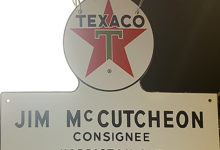
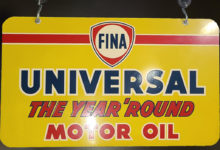
Redes Sociais - Comentários